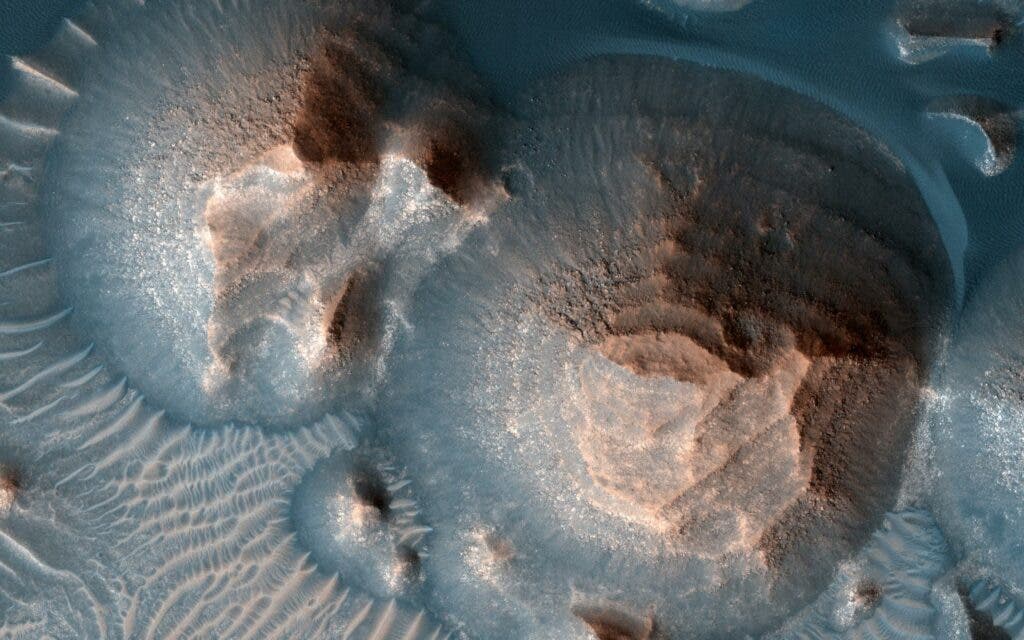
Whether or not Mars is still volcanically active is still a matter of debate. What’s certain is true is that, in the past, the red planet was very volcanically active — and then some. Most of Mars’ volcanism occurred between three and four billion years ago, spawning giant geological features such as the 25-km-tall (16-mile) Olympus Mons, the highest mountain in the solar system.
Recently, NASA found evidence that a region of northern Mars called Arabia Terra experienced thousands of so-called “super-eruptions” over a 500-million-year period.
These kinds of eruptions, the most violent volcanic explosions known to science, were no joke. Relatively small volcanic eruptions on Earth are known to release carbon dioxide, sulfur dioxide, and other aerosols that can block sunlight and significantly reduce surface temperature.
The same happened on Mars, but only on a more massive scale. One single super eruption could have blasted out the equivalent of 400 million Olympic-size swimming pools worth of molten rock and gas.
“Each one of these eruptions would have had a significant climate impact — maybe the released gas made the atmosphere thicker or blocked the Sun and made the atmosphere colder,” said Patrick Whelley, a geologist at NASA’s Goddard Space Flight Center in Greenbelt, Maryland, who led the Arabia Terra analysis. “Modelers of the Martian climate will have some work to do to try to understand the impact of the volcanoes.”
Mars’ surface is littered with craters. Anywhere you go, you’re bound to find at least one within a couple of hundred kilometers. These craters are formed by one of two processes: impact (with a comet, meteorite, or asteroid), or by volcanic eruptions.
When very large volcanoes reach the end of their lifetimes, they collapse into a giant hole called a caldera, some of which can be dozens of kilometers wide. It was several of these calderas identified across Arabia Terra that prompted NASA scientists to look closer.
Unlike impact craters, which tend to be perfectly round, calderas bear signs of collapse such as deeper floors and benches of rock near the walls. However, there ought to be many other calderas in the region that haven’t been spared by the passage of time in the same way as these obviously visible formations.
The researchers decided to look for signs of ancient calderas by looking for ash “because you can’t hide that evidence,” Whelley said. So they used data from NASA’s Mars Reconnaissance Orbiter (MRO) to look for signs of ash across Arabia Terra, finding many well-preserved layers of the material.
When the researchers crunched the numbers, they figured that it would’ve taken thousands of supervolcanic eruptions to deposit the amount of ash registered in the data.
On Earth, volcanoes capable of super-eruptions are distributed around the globe, along with other volcano types. The last such cataclysmic eruption occurred 76,000 years ago in Sumatra, Indonesia. In contrast, Arabia Terra is littered with only one type of volcano, a mysterious oddity that scientists can’t yet explain. Arabia Terra is the only place on Mars where we found evidence of explosive volcanoes.
In the meantime, researchers are still busy combing through the MRO data to better understand the geological process that shaped the solar system’s planets and moons.
“People are going to read our paper and go, ‘How? How could Mars do that? How can such a tiny planet melt enough rock to power thousands of super eruptions in one location?’” said Jacob Richardson, a geologist at NASA Goddard. “I hope these questions bring about a lot of other research.”
The findings appeared in the journal Geophysical Research Letters.






